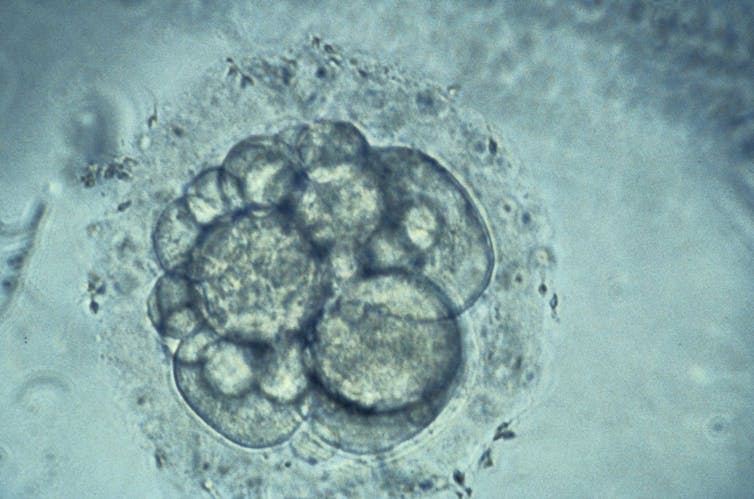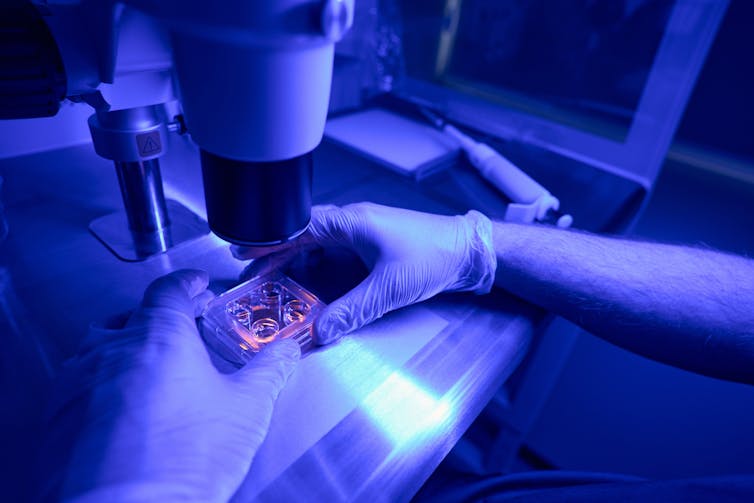
On June 14, 2023, developmental biologist Magdalena Żernicka-Goetz presented her research on creating human embryos using stem cells at the 2023 annual meeting of the International Society for Stem Cell Research (ISSCR).
This research could increase our understanding of human development and genetic disorders, help us learn how to prevent early miscarriages, lead to improvements in fertility treatment, and — perhaps — eventually allow for reproduction without using sperm and eggs.
Beyond the limits
Synthetic human embryos — also called embryoid bodies, embryo-like structures or embryo models — mimic the development of “natural human embryos,” those created by fertilization. Synthetic human embryos include the “cells that would typically go on to form the embryo, placenta and yolk sac, and develop to form the precursors of germ cells (that will form sperm and eggs).”
Though research involving natural human embryos is legal in many jurisdictions, it remains controversial. For some people, research involving synthetic human embryos is less controversial because these embryos cannot “develop to the equivalent of postnatal stage humans.” In other words, these embryos are non-viable and cannot result in live births.
In addition, some maintain that the creation of synthetic human embryos would allow for research beyond the 14-day limit that typically applies to natural human embryos.
But would it?
Laws in the United Kingdom
The research presented by Żernicka-Goetz at the ISSCR meeting took place in the United Kingdom. It was conducted in accordance with the Human Fertilization and Embryology Act, 1990, with the approval of the U.K. Stem Cell Bank Steering Committee.
U.K. law limits the research use of human embryos to 14 days of development. An embryo is defined as “a live human embryo where fertilisation is complete, and references to an embryo include an egg in the process of fertilisation.”
Synthetic embryos are not created by fertilization and therefore, by definition, the 14-day limit on human embryo research does not apply to them. This means that synthetic human embryo research beyond 14 days can proceed in the U.K.
The door to the touted potential benefits — and ethical controversies — seems wide open in the U.K.
Canadian law
While the law in the U.K. does not apply to synthetic human embryos, the law in Canada clearly does. This is because the legal definition of an embryo in Canada is not limited to embryos created by fertilization.
The Assisted Human Reproduction Act (the AHR Act) defines an embryo as “a human organism during the first 56 days of its development following fertilization or creation, excluding any time during which its development has been suspended.”
Based on this definition, the AHR Act applies to embryos created by reprogramming human embryonic stem cells — in other words, synthetic human embryos — provided such embryos qualify as human organisms.
A synthetic human embryo is a human organism. It is of the species Homo sapiens, and is thus human. It also qualifies as an organism — a life form — alongside other organisms created by means of fertilization, asexual reproduction, parthenogenesis or cloning.
The definition of an organism does not stipulate a specific means of creation and so can include creation by means of reprogramming embryonic stem cells.

Limitations
Given that the AHR Act applies to synthetic human embryos, there are legal limits on their creation and use in Canada.
First, human embryos — including synthetic human embryos – can only be created for the purposes of “creating a human being, improving or providing instruction in assisted reproduction procedures.”
Given the state of the science, it follows that synthetic human embryos could legally be created for the purpose of improving assisted reproduction procedures.
Second, “spare” or “excess” human embryos — including synthetic human embryos — originally created for one of the permitted purposes, but no longer wanted for this purpose, can be used for research. This research must be done in accordance with the consent regulations which specify that consent must be for a “specific research project.”
Finally, all research involving human embryos — including synthetic human embryos — is subject to the 14-day rule. The law stipulates that: “No person shall knowingly… maintain an embryo outside the body of a female person after the fourteenth day of its development following fertilization or creation, excluding any time during which its development has been suspended.”
Putting this all together, the creation of synthetic embryos for improving assisted human reproduction procedures is permitted, as is research using “spare” or “excess” synthetic embryos originally created for this purpose — provided there is specific consent and the research does not exceed 14 days.
This means that while synthetic human embryos may be useful for limited research on pre-implantation embryo development, they are not available in Canada for research on post-implantation embryo development beyond 14 days.

Prospects for expansion
Proponents of synthetic human embryo research beyond 14 days may argue for a different interpretation of the law and insist that synthetic human embryos are not “human embryos” as defined in the AHR Act. But this looks to be an impossible task.
Alternatively, they may insist there is an important moral distinction between natural and synthetic human embryos because synthetic human embryos lack the potential to become live born humans. This means they fall into the category of non-viable human embryos.
It is not the case, however, that all natural embryos are viable embryos, and that all synthetic embryos are non-viable embryos. There are non-viable natural embryos such as tri-pronuclear embryos, where more than one sperm enters the egg during fertilization.
And one day, synthetic human embryos may be viable embryos. In any case, in Canada, viable and non-viable embryos are legally equivalent. They are subject to the same rules, including the 14-day limit.
This leaves proponents of synthetic human embryo research beyond 14 days with the need for an alternative argument. But any argument will have to overcome the political reality that the federal government is unlikely to open up the Pandora’s box of amending the AHR Act.
It therefore seems likely that synthetic human embryo research will remain limited in Canada for the foreseeable future.
Françoise Baylis, Distinguished Research Professor, Emerita, Dalhousie University and Jocelyn Downie, Professor, Faculties of Law and Medicine, Dalhousie University
This article is republished from The Conversation under a Creative Commons license. Read the original article.











